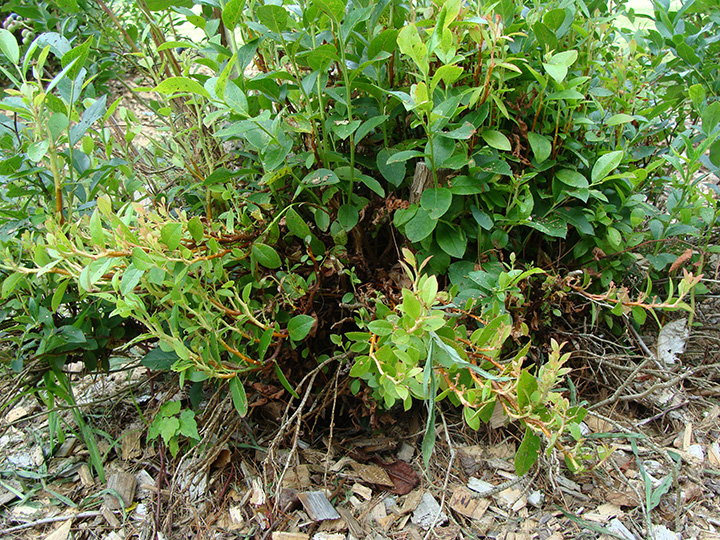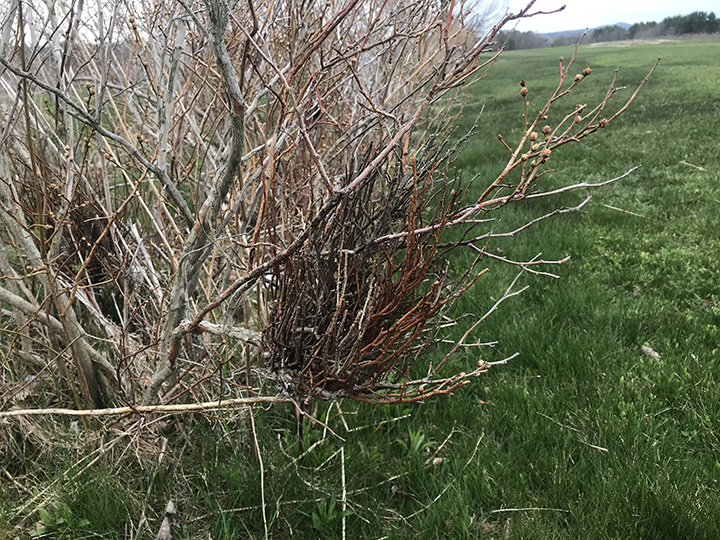Witches’ Broom of Blueberries
Pest Management Fact Sheet #5066
Developed by Alicyn Smart, D.P.M., Assistant Extension Professor & Extension Plant Pathologist, David Handley, Ph.D., Vegetable & Small Fruit Specialist, University of Maine Cooperative Extension, and Abigayl Novak, Undergraduate Student, University of Maine.
For information about UMaine Extension programs and resources, visit extension.umaine.edu.
Find more of our publications and books at extension.umaine.edu/publications/.
Pathogen: Pucciniastrum goeppertianum (syn. Calyptospora goeppertiana)
Introduction
Witches’ broom of blueberries is a fungal disease that is considered to be a minor problem in highbush and lowbush blueberries in most regions but is quite prevalent in Maine. Blueberry plantings can become heavily infected when they are in close proximity to balsam fir (Abies balsamea), which is the alternate host of this fungus. Having fir trees close by to act as an alternate host is necessary for the fungus to complete its life cycle. Christmas tree growers are therefore strongly discouraged from raising blueberries on the same property to avoid encouraging this disease.
The witches’ broom fungus, Pucciniastrum goeppertianum produces three fungal fruiting structures that produce different spores, depending on which host it is infecting. Spermagonia and aecia fruiting structures are found on firs, and telia are formed on blueberries and some other Vaccinium spp. In the spring and early summer, aeciospores are produced on balsam fir needles and are carried by wind to susceptible blueberry plants. The fungus then infects blueberry plants systemically. Although infected with the disease, plants do not show symptoms in the first year of infection. The following year, symptoms may easily be seen in the late summer and fall. Telia develop in the fall to overwinter on the swollen shoots of the infected blueberry plants. The next spring, the telispores germinate and produce basidopsores that are carried by wind from the blueberry plants to balsam fir trees, where they infect the current year’s needles.
Host Plants
Highbush blueberries (V. corymbosum) are most susceptible; lowbush blueberry (V. angustifolium), and other Vaccinium spp., including:
- Dwarf bilberry ( V. caespitosum), cascade bilberry (V. deliciosum), thinleaf huckleberry (V. membranaceum), velvetleaf huckleberry (V. myrtilloides), grouseberry (V. scoparium), and mountain cranberry (V. vitis-idaea)
Symptoms & Signs
Infected blueberry plants have broom-like masses of swollen, spongy shoots with shortened internodes and leaves that are smaller than normal. Symptomatic shoots have a reddish yellow color and turn brown and shiny throughout the growing season. As the season progresses, the brooms become dried out and cracked. They will appear dead the following spring.
Balsam fir trees that are infected can experience stunted growth with yellowish-green colored needles. When the spores develop, they appear as small round orange-yellow blisters, occurring mostly on the undersides of the needles.



Management
- Because this disease is systemic, i.e. it moves and spreads internally through the plant, burning or cutting out the brooms will not provide control. However, experience in Maine has shown that the symptoms can be managed with judicious pruning, allowing infected plants to remain productive, often for many years, in spite of the disease. It is suggested that broom growth be pruned out as soon as it appears and that the entire branch or cane on which the broom appears, be removed to slow the spread of the fungus through the plant. Once the infection has developed to the extent that heavy broom growth is emerging from the base of the plant and no healthy new canes are emerging, it is best to remove the plant.
- Removing any and all balsam fir trees within a quarter-mile of blueberry plants, if possible, can reduce or even eliminate witches’ broom. Even if it is not possible to clear balsam to that distance, it is best to keep blueberries and balsam separated to the greatest extent possible.
- Although susceptibility to witches’ broom appears to vary among different blueberry varieties, and some such as ‘Rancocas’, may have resistance to the disease, this has yet not been adequately studied.
At this time, there are no effective fungicides for managing witches’ broom.
References
- Polashock, James J., et al. Compendium of Blueberry, Cranberry, and Lingonberry Diseases and Pests. American Phytopathological Society, 2017.
- Sinclair, Wayne A. and Howard H. Lyon. Diseases of Trees and Shrubs. Cornell University, 2005.
- Yellow witches’ broom of balsam fir. 4 August 2015. https://tidcf.nrcan.gc.ca/en/diseases/factsheet/27. 17 July 2019.
WHEN USING PESTICIDES, ALWAYS FOLLOW LABEL DIRECTIONS!
Alicyn Smart, DPM
Plant Pathologist and Director of the Plant Disease Diagnostic Laboratory
University of Maine Cooperative ExtensionInformation in this publication is provided purely for educational purposes. No responsibility is assumed for any problems associated with the use of products or services mentioned. No endorsement of products or companies is intended, nor is criticism of unnamed products or companies implied.
© 2020
Call 800.287.0274 (in Maine), or 207.581.3188, for information on publications and program offerings from University of Maine Cooperative Extension, or visit extension.umaine.edu.
In complying with the letter and spirit of applicable laws and pursuing its own goals of diversity, the University of Maine System does not discriminate on the grounds of race, color, religion, sex, sexual orientation, transgender status, gender, gender identity or expression, ethnicity, national origin, citizenship status, familial status, ancestry, age, disability physical or mental, genetic information, or veterans or military status in employment, education, and all other programs and activities. The University provides reasonable accommodations to qualified individuals with disabilities upon request. The following person has been designated to handle inquiries regarding non-discrimination policies: Director of Institutional Equity and Title IX Services, 5713 Chadbourne Hall, Room 412, University of Maine, Orono, ME 04469-5713, 207.581.1226, TTY 711 (Maine Relay System).

